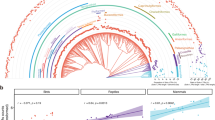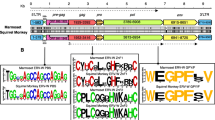Abstract
Endogenous retrovirus (ERV) integrates into the germline of its host and could remain in the genome as a molecular fossil. ERV is one of sources that cause INDEL and recombination events in the vertebrate genomes, leading to various genomic and genetic changes in their hosts. There have been many studies conducted on ERVs in the vertebrate genomes to elucidate their evolutionary history. However, ERVs have not been studied well in Crocodylus siamensis. Here, we report structural variations among SFV1 elements (simian foamy virus-like), ERVs in C. siamensis. We initially identified 26 SFV1 candidates in the genome and experimentally verified 9 SFV1_1 and 5 SFV1_10 elements using PCR display. Their structural analyses showed that most of them are solitary-LTRs but two SFV1_1 elements are full-length. Through further analyses, we found that the two full-length elements retain intact ORFs. We examined transcription factor binding sites within their LTR sequences to predict promoter/enhancer activities. In sum, we identified 14 crocodile-specific SFV1 elements and the results of their structural analyses suggest that they could contribute to genomic or phenotypic variations in C. siamensis population.






Similar content being viewed by others
References
Belshaw R, Pereira V, Katzourakis A, Talbot G, Paces J, Burt A, Tristem M (2004) Long-term reinfection of the human genome by endogenous retroviruses. Proc Natl Acad Sci USA 101:4894–4899
Bohne A, Brunet F, Galiana-Arnoux D, Schultheis C, Volff JN (2008) Transposable elements as drivers of genomic and biological diversity in vertebrates. Chromosome Res 16:203–215
Brochu CA (2000) Phylogenetic relationships and divergence timing of crocodylus based on morphology andthe fossil record. Copeia 2000:657–673
Chong AY, Kojima KK, Jurka J, Ray DA, Smit AF, Isberg SR, Gongora J (2014) Evolution and gene capture in ancient endogenous retroviruses: insights from the crocodilian genomes. Retrovirology 11:71
Chong AY, Kjeldsen SR, Gongora J (2015) Surveys of endogenous retroviruses (ERVs) in the freshwater crocodile (Crocodylus johnstoni) suggest that ERVs in Crocodylus spp. vary between species. Virus Genes 50:329–332
Cui P, Lober U, Alquezar-Planas DE, Ishida Y, Courtiol A, Timms P, Johnson RN, Lenz D, Helgen KM, Roca AL et al (2016) Comprehensive profiling of retroviral integration sites using target enrichment methods from historical koala samples without an assembled reference genome. PeerJ 4:e1847
Dinets V (2013) Long-distance signaling in Crocodylia. Copeia 3:517–526
Fujiwara T, Mizuuchi K (1988) Retroviral DNA integration: structure of an integration intermediate. Cell 54:497–504
Goff SP (2007) Host factors exploited by retroviruses. Nat Rev Microbiol 5:253–263
Green RE, Braun EL, Armstrong J, Earl D, Nguyen N, Hickey G, Vandewege MW, St John JA, Capella-Gutierrez S, Castoe TA et al (2014) Three crocodilian genomes reveal ancestral patterns of evolution among archosaurs. Science 346:1254449
Hall TA (1999) BioEdit: a user-friendly biolodgical sequence alignment editor and analysis program for Windows 95/98/NT. Nucleic Acids Sympos 41:95–98
Hugall AF, Foster R, Lee MS (2007) Calibration choice, rate smoothing, and the pattern of tetrapod diversification according to the long nuclear gene RAG-1. Syst Biol 56:543–563
Jern P, Sperber GO, Blomberg J (2005) Use of endogenous retroviral sequences (ERVs) and structural markers for retroviral phylogenetic inference and taxonomy. Retrovirology 2:50
Johnson WE, Coffin JM (1999) Constructing primate phylogenies from ancient retrovirus sequences. Proc Natl Acad Sci USA 96:10254–10260
Jones DT, Taylor WR, Thornton JM (1992) The rapid generation of mutation data matrices from protein sequences. Comput Appl Biosci 275–282
Kapitonov VV, Jurka J (2008) A universal classification of eukaryotic transposable elements implemented in Repbase. Nat Rev Genet 9:411–412 (author reply 414)
Karolchik D, Hinrichs AS, Furey TS, Roskin KM, Sugnet CW, Haussler D, Kent WJ (2004) The UCSC table browser data retrieval tool. Nucleic Acids Res 32:D493–D496
Kimura M (1980) A simple method for estimating evolutionary rates of base substitutions through comparative studies of nucleotide sequences. Mol Evol Int J Org Evol 16:111–120
Lee J, Mun S, Kim DH, Cho CS, Oh DY, Han K (2017) Chicken (Gallus gallus) endogenous retrovirus generates genomic variations in the chicken genome. Mob DNA 8:2
Llorens C, Fares MA, Moya A (2008) Relationships of gag-pol diversity between Ty3/Gypsy and Retroviridae LTR retroelements and the three kings hypothesis. BMC Evol Biol 8:276
Lower R, Lower J, Kurth R (1996) The viruses in all of us: characteristics and biological significance of human endogenous retrovirus sequences. Proc Natl Acad Sci USA 93:5177–5184
Magiorkinis G, Gifford RJ, Katzourakis A, De Ranter J, Belshaw R (2012) Env-less endogenous retroviruses are genomic superspreaders. Proc Natl Acad Sci USA 109:7385–7390
McCarthy EM, McDonald JF (2004) Long terminal repeat retrotransposons of Mus musculus. Genome Biol 5:R14
McVey M, Lee SE (2008) MMEJ repair of double-strand breaks (director’s cut): deleted sequences and alternative endings. Trends Genet 24:529–538
Mun S, Lee J, Kim YJ, Kim HS, Han K (2014) Chimpanzee-specific endogenous retrovirus generates genomic variations in the chimpanzee genome. PLoS ONE 9:e101195
Nelson PN, Hooley P, Roden D, Davari Ejtehadi H, Rylance P, Warren P, Martin J, Murray PG, Molecular Immunology Research Group (2004) Human endogenous retroviruses: transposable elements with potential? Clin Exp Immunol 138:1–9
Pray LA (2008) Transposons: the jumping genes. Nat Educ 1:204
Roos J, Aggarwal RK, Janke A (2007) Extended mitogenomic phylogenetic analyses yield new insight into crocodylian evolution and their survival of the cretaceous-tertiary boundary. Mol Phylogenet Evol 45:663–673
Ross JP (1988) Crocodiles, 2nd edn. IUCN, Gland
Ross FD, Mayer GC (1983) On the dorsal armor of the Crocodilia. Adv Herpetol Evol Biol 305–331
Shin W, Lee J, Son SY, Ahn K, Kim HS, Han K (2013) Human-specific HERV-K insertion causes genomic variations in the human genome. PLoS ONE 8:e60605
Sperber G, Lovgren A, Eriksson NE, Benachenhou F, Blomberg J (2009) RetroTector online, a rational tool for analysis of retroviral elements in small and medium size vertebrate genomic sequences. BMC Bioinform 10(Suppl 6):S4
Srikulnath K, Thongpan A, Suputtitada S, Apisitwanich S (2012) New haplotype of the complete mitochondrial genome of Crocodylus siamensis and its species-specific DNA markers: distinguishing C. siamensis from C. porosus in Thailand. Mol Biol Rep 39:4709–4717
Srikulnath K, Thapana W, Muangmai N (2015) Role of chromosome changes in Crocodylus evolution and diversity. Genom Inform 13:102–111
St John JA, Braun EL, Isberg SR, Miles LG, Chong AY, Gongora J, Dalzell P, Moran C, Bed’hom B, Abzhanov A et al (2012) Sequencing three crocodilian genomes to illuminate the evolution of archosaurs and amniotes. Genome Biol 13:415
Stocking C, Kozak CA (2008) Murine endogenous retroviruses. Cell Mol Life Sci 65:3383–3398
Stoye JP (2001) Endogenous retroviruses: still active after all these years? Curr Biol 11:R914–916
Supikamolseni A, Ngaoburanawit N, Sumontha M, Chanhome L, Suntrarachun S, Peyachoknagul S, Srikulnath K (2015) Molecular barcoding of venomous snakes and species-specific multiplex PCR assay to identify snake groups for which antivenom is available in Thailand. Genet Mol Res 14:13981–13997
Tamura K, Stecher G, Peterson D, Filipski A, Kumar S (2013) MEGA6: molecular evolutionary genetics analysis version 6.0. Mol Biol Evol 30:2725–2729
Tsangaras K, Mayer J, Alquezar-Planas DE, Greenwood AD (2015) An evolutionarily young polar bear (Ursus maritimus) endogenous retrovirus identified from next generation sequence data. Viruses 7:6089–6107
Vizcaino C, Mansilla S, Portugal J (2015) Sp1 transcription factor: a long-standing target in cancer chemotherapy. Pharmacol Ther 152:111–124
Weiss RA (2006) The discovery of endogenous retroviruses. Retrovirology 3:67
Wicker T, Sabot F, Hua-Van A, Bennetzen JL, Capy P, Chalhoub B, Flavell A, Leroy P, Morgante M, Panaud O et al (2007) A unified classification system for eukaryotic transposable elements. Nat Rev Genet 8:973–982
Zhang X, Diab IH, Zehner ZE (2003) ZBP-89 represses vimentin gene transcription by interacting with the transcriptional activator, Sp1. Nucleic Acids Res 31:2900–2914
Acknowledgements
The present work was conducted with funding from the Research Fund of Dankook University in 2015.
Author information
Authors and Affiliations
Corresponding author
Ethics declarations
Conflict of interest
Panupon Twilprawat declares that he/she does not have conflict of interest. Songmi Kim declares that he/she does not have conflict of interest. Kornsorn Srikulnath declares that he/she does not have conflict of interest. Kyudong Han declares that he/she does not have conflict of interest.
Ethical approval
Animal care and all experimental procedures were approved by the Animal Experiment Committee, Kasetsart University, Thailand (approval no. ACKU04959), and conducted according to the Regulations on Animal Experiments at Kasetsart University.
Electronic supplementary material
Below is the link to the electronic supplementary material.
13258_2017_581_MOESM1_ESM.pptx
Supplementary Fig. 1 Cladogram between the SFV1_1 and SFV1_10 subfamilies.The maximum-likelihood cladogram of SFV1_1 and SFV1_10 subfamilies was constructed using 14 LTR sequences from SFV1 elements. The pink and green highlights represent SFV1_1 and SFV1_10 subfamilies, respectively. The red- and green-colored characters indicate SFV1_1 and SFV1_10 consensus LTR sequences, respectively. (PPTX 117 KB)
Rights and permissions
About this article
Cite this article
Twilprawat, P., Kim, S., Srikulnath, K. et al. Structural variations generated by simian foamy virus-like (SFV) in Crocodylus siamensis . Genes Genom 39, 1129–1138 (2017). https://doi.org/10.1007/s13258-017-0581-0
Received:
Accepted:
Published:
Issue Date:
DOI: https://doi.org/10.1007/s13258-017-0581-0




